
This morning’s breakfast: pears fresh from the tree by the kitchen, caramelized in butter. Fresh lemon and honey squeezed over top while still hot.

This morning’s breakfast: pears fresh from the tree by the kitchen, caramelized in butter. Fresh lemon and honey squeezed over top while still hot.
It’s the time of year to pickle everything – saving this season’s abundance for future seasons. We have a ton of hot peppers right now – jalapenos, fish peppers, habaneros, and a couple others. Pickling is the least dangerous way to deal with them without having to get your hands spicy. Just pack a jar full of peppers, adding a few cloves of garlic, and top off with a vinegar watered down to your liking, plus salt. Since the overall quantity of jars of peppers is still low compared to other harvests for salsa, sauce, etc, I don’t bother to can them – just keep them in the fridge. My favorite pickles retain most of the crispness of the raw vegetable, are sour, salty, garlicky, and spicy. Green beans are perfect for this. I don’t usually care for sweet pickles, but I did include some fruit in one of the pickled pepper jars. Apple slices, grapes, beets, ginger, and carrots accompany the hot peppers. I love the fruity-spicy-gingery combination, plus the color. The peppers are starting to soften up, but the apples are still very crisp.
I must repeat a flavorful hot sauce that I made this week, which is already eaten up! It’s half roasted garlic, a quarter roasted tomatoes, and a quarter roasted jalapenos & fish peppers, blended in a food processor with rice wine vinegar, salt, and oregano.
I’m enjoying picking the occasional pear to snack on, but the tree looms heavy with fruit to be processed soon. More pear tarts, sauce, cider, salads, dried chips, & perhaps wine.
We’ve been gathering fruity riches this month: apples, grapes, pears, oh my! It is a very prosperous fruit year. Melons, jalapenos and fish peppers, as well as green beans, are also doing well this year.
Here we have some of the treats I’ve made this August: green tomato & cheese Dutch baby, strawberry-pear cobbler, and apple cake with a sweet hummus frosting.
For the Dutch baby, I sliced green tomatoes and placed them in the cast iron skilled with butter & oregano to pre-cook in a 415 F oven for 5 minutes. I added chunks of mozzarella to the egg/milk/flour batter and poured it over the tomato/butter skillet and quickly returned to the oven for 20 minutes. Squeeze a fresh lemon wedge over the pancake before serving.
For the cobbler, I pressed a shortbread crust into the bottom of a pan, topped with a mixture of strawberry chunks, thinly sliced pears, & sugar, and then crumbled some shortbread on top, streusel-style. Baked in a 375 F oven til firm.
For the apple cake, I diced our homegrown apples and mixed them into a VGF cake batter with buckwheat flour, cinnamon, fresh ginger, nutmeg, a pinch of cloves, a splash of apple cider vinegar, oil, sugar, molasses, and baking powder. While it baked for a good 35 minutes at 350 F, I made the frosting in our powerful new food processor. Chickpeas (cooked soft or from a can), tahini, vanilla, applesauce, and confectioners’ sugar, blended until ultra-smooth. Once the cake cooled, I spread the sweet hummus on top, then sprinkled with cinnamon & fresh apple slices. Some folks are unsure about the “sweet hummus” at first, but are sold at first taste – no garlic of course! It tastes reminiscent of halva, a sweet tahini treat.
It has been a busy June, celebrating our farm community’s 50th year. I’m behind in blogging, but have been cooking quite a bit. Now that the huge party is over, hopefully my focus can return. So far this week I only managed to take a few slightly blurry photos (again, focus needed)… I cook a community dinner every Wednesday, and this week I made a big pasta salad with yellow summer squash, sundried tomatoes, olives, fresh parsley & basil, green peppers, cukes, & roasted garlic. This meal also included cukes with shredded beets & fresh dill & tarragon, strawberry-apple cobbler, local cheddar, kale salad with kimchi, and a chili leftover from the cookout. What better describes summer nosh than cold salads studded with fresh, colorful veggies?
Sunday, another brunch day – today I’m enjoying an assortment of our homemade pickled veggies: okra, beets, garlic scapes, turnips, and jalapenos (which can be a bit of a Russian roulette). We pickle cukes and almost anything extra – but the garlic scapes & okra are my favorites! I like pickles with zing and tons of garlic (not with sugar).
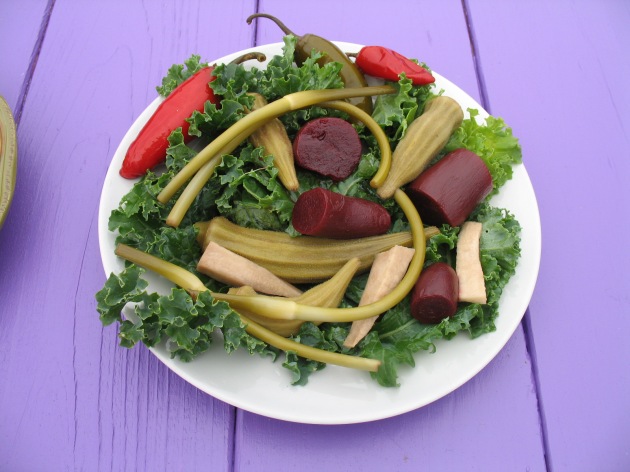
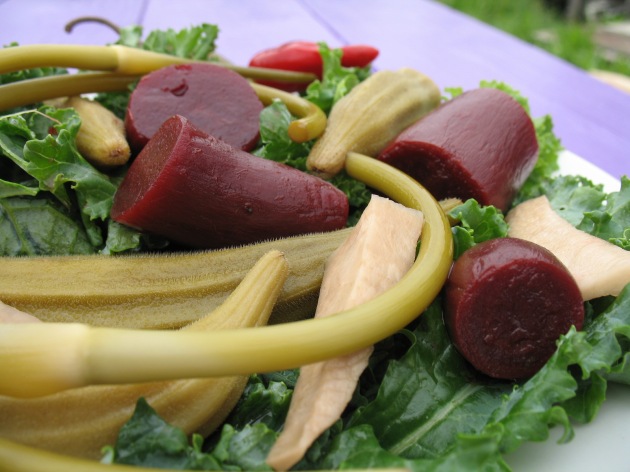

I also veganized an awesome recipe from King Arthur Flour, which I ran across on WordPress adapted here by Cooking is my Sport: Curry Ginger scones! Oh, they were so good, this is now one of my favorite scones! I was impressed with the sweet & savory combination and the way the small amount of curry brings out another side of ginger, which I do love to use copiously. I’m not sure why but there are lovely red speckles throughout. I did a few things different from the recipe – used water and palm oil instead of dairy, non-crystallized shredded ginger root, added some oats & cinnamon (so they had a hint of gingerbread), and forgot to add the pumpkin puree somehow. They still turned out quite moist, spicier and sweeter than I’d expected. As you can see, I couldn’t stop eating them while photographing them.

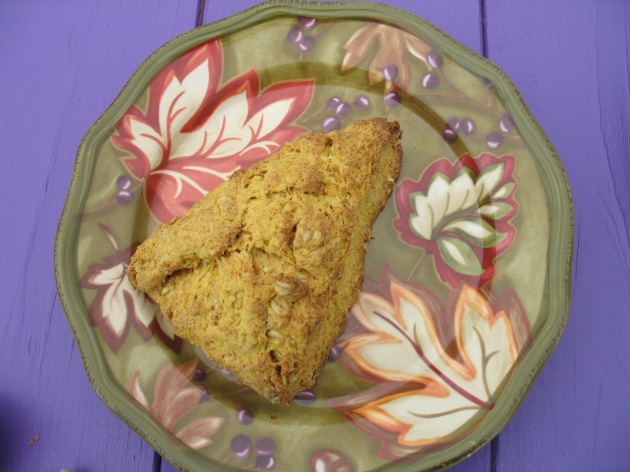
It’s kind of funny how certain dishes become favorites/standards. I’ve spent the past 10 + years cooking at this 100-person farm community, have cooked a wide variety of dishes with varying popularity, from gnocchi to raw VGF dressings and everything in between. My usual back-up list of dishes that are easy to fill in an empty slot at a meal includes mac & cheese, lentils, spiced rice, spiced molasses cake, baked potatoes, garlic bread, salads, and of course whichever veggies are in seasonal abundance. But it wasn’t until this year that I developed a recipe that seems to have become a popular staple here, that could get made fresh and eaten up each day, that’s also easy enough to make with cheap enough ingredients. I started making these peanut bars as an easy grab-and-go snack that’s also semi-nutritious, with protein and not super sweet, and even sneak some whole grains in there. Something quickly accessible to our busy farmers and factory workers, since we supply lots of ingredients & leftovers, but not so many ready snacks. There’s homemade granola, bread, yogurt, and things that require bowls. This treat may not be from the garden, but it’s homemade & well-loved. Now I make this recipe (which fills our largest sheet pan) a couple times a week, and they all get gobbled up.
I use organic peanut butter (smooth or crunchy) from our friends at East Wind Nut Butters in Missouri. They also make a delicious “mystery butter,” with part cashew, part almond butter and sometimes a hint of tahini – that worked well when I tried it in this recipe once, so if you don’t eat peanuts, feel free to substitute any nut butter. Peanuts and sunflower seeds, easily grown domestically, are cheaper, more sustainable nuts than almonds, cashews, or the like. As much as I love almonds and cashews, they take tons of water to grow, are often imported, and take more labor to process.
For the flax preparation, an egg replacer, I grind flax seeds and mix them into a cup of water and microwave it for 45 seconds, stir, and repeat twice until it’s boiling and bubbling and thickened to an egg-like consistency (it may thicken slightly while cooling). I do this in a larger cup than necessary, say a pint measuring cup, because it likes to boil over sometimes. You could also boil a kettle of water, and pour the water over the ground flax, stir, and let sit for a few minutes, but it doesn’t quite thicken the same.
For sweetener, I usually use fake maple syrup, which still disappoints the Vermonter in me. I would love to use real maple syrup instead of the mostly-corn-syrup stuff, but it is cost-prohibitive, especially in the South. Most folks outside of maple states grow up with fake maple as the norm, an exception made for corn syrup by those who usually shun it. It strikes me as less sustainable than the real stuff as well as less healthy. Personally I have a strong preference for the taste of real maple, having grown up with it dripping just a few feet from my house. It’s expensive in Vermont too, but there it is often an exception item in people’s budgets, the quality and locality is valued, sometimes neighbors trade maple for other items, a natural bartering gold. Honey works well for this recipe, but is also expensive – same with agave, which is imported. Our farm also trades with Sandhill Community for sorghum, which is like a dark honey. Use whichever your sweetening preference is.
Peanut Butter Bars
4 c oats
4 c peanut butter
1/3 c molasses
4 c maple syrup (or honey, sorghum, agave, etc)
2 TB vanilla
1 tsp cinnamon
2 tsp salt
1 TB baking powder
6 cups all-purpose flour
flaxseed preparation of 4 tsp ground flaxseed with 3/4 c hot water (see above for preparation instructions)
Sift together the all-purpose flour & baking powder. Mix all other ingredients separately, then combine with flour mix. Dough/batter will be sticky. Spread it out evenly about a half an inch thick, patting with your hands (wet your hands with water or oil first, or a dusting of flour, to combat the stickiness). Bake at 350 F for 20 minutes. Allow to cool slightly for 10 minutes, then cut into bars while still warm.


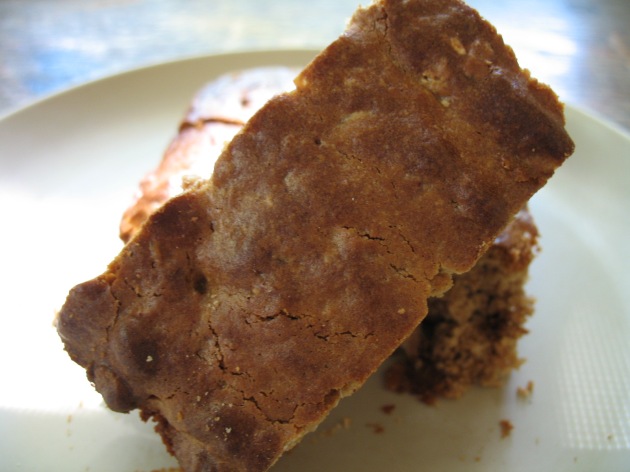
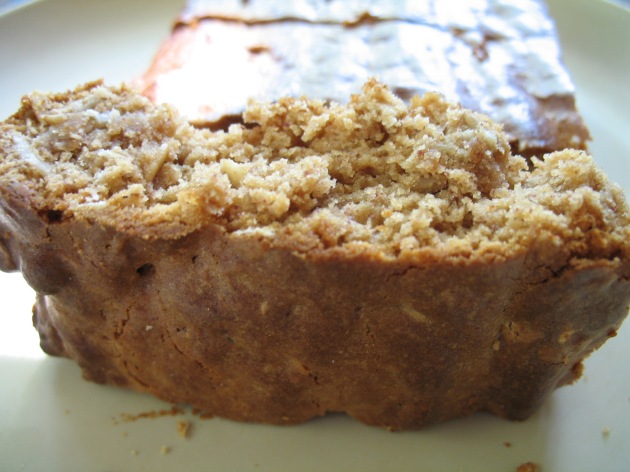
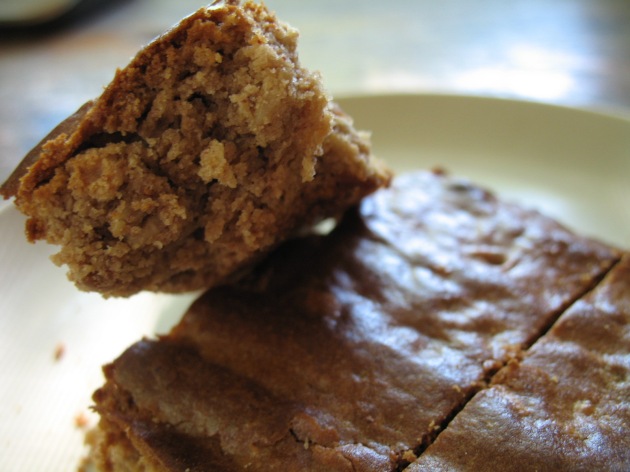
I’m in love with chives this year! I’ve always liked them, but for some reason they are just shining this month. Chives chopped finely are the freshest green garnish of the season. They add a small bite, a nip of allium flavor. The tiny chive is a reminder of larger vegetables to come soon.
Some weekends growing up, my mom used to make what we called “special pancake,” which we served with Vermont maple syrup and a splash of lemon juice. I’ve also heard it called Jacob’s pancake, Dutch baby, and “failed popover.” The recipe is very simple, and similar to popovers, just two eggs, a cup of milk, a half-cup flour, and butter pre-melted in the pan while the oven’s heating up. Flavor it however you feel like, whether plain, or with thinly sliced apples & cinnamon, or shredded cheese. Today I have mixed in a handful of chives, fresh sage, one of the first yellow summer squashes, salt & pepper, and a small pinch of nutmeg. Bake for 20-25 minutes in a 400 F degree preheated oven. When it is approaching golden brown, and poofed up in random beauty, it is done. Serve immediately, or watch it deflate in a few minutes.
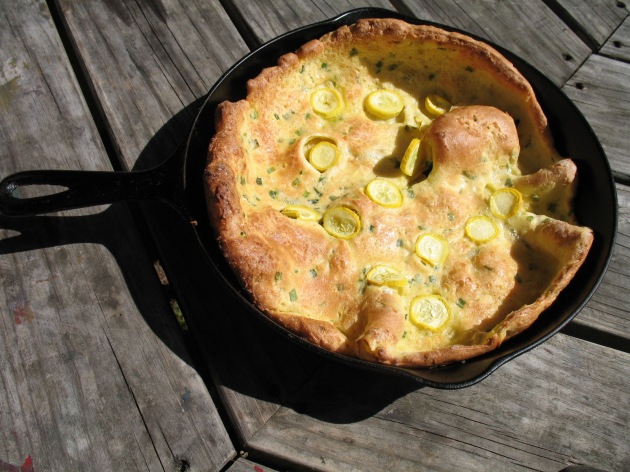
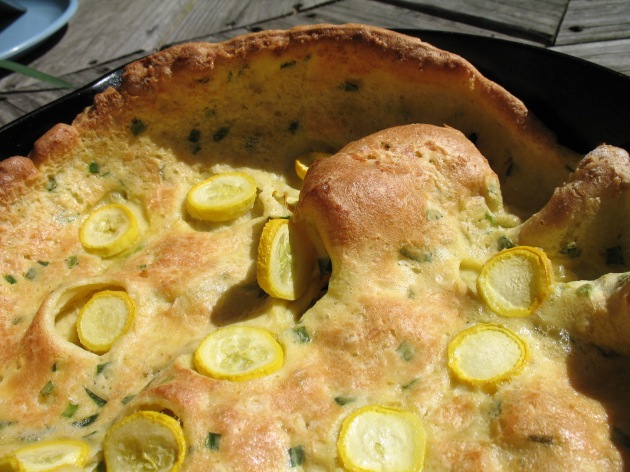
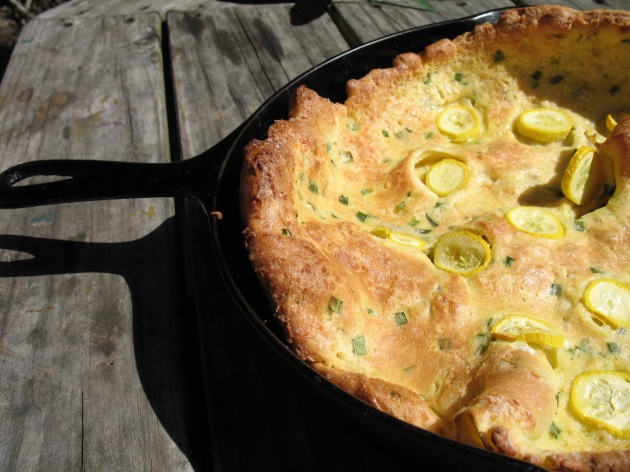
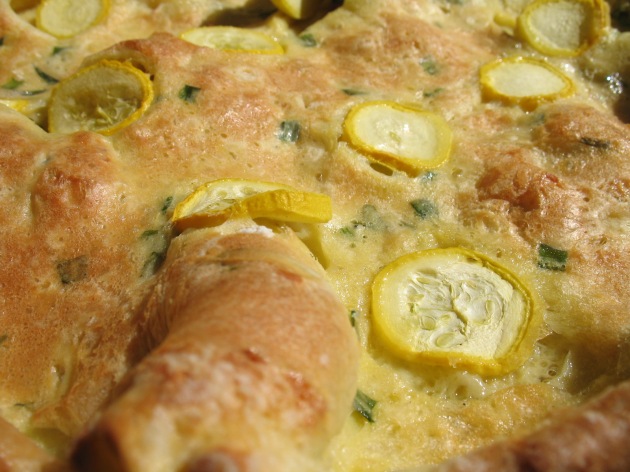
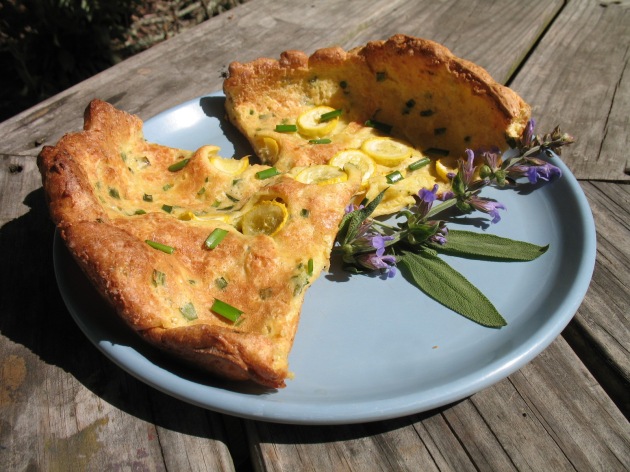
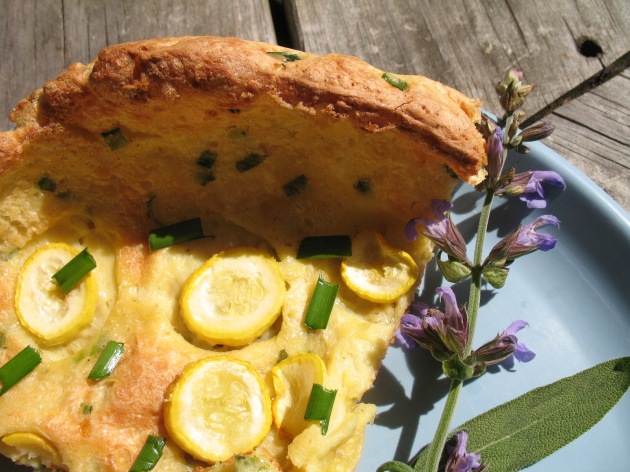



Garlic scape season is here! Here is one more colorful spring salad, with finely chopped scapes, purple radishes, shredded raw beet, spinach, olive oil, lemon, salt & pepper.


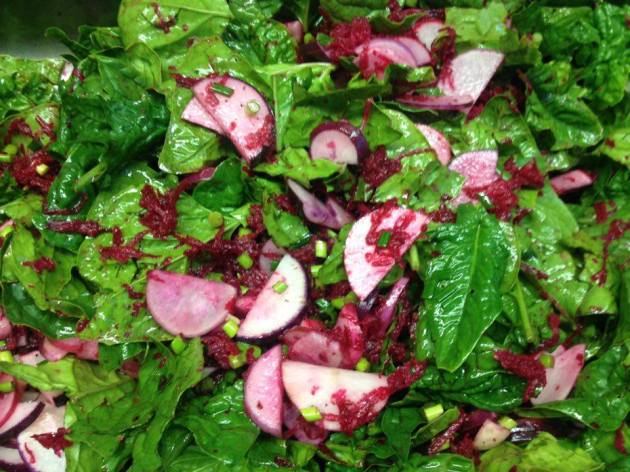
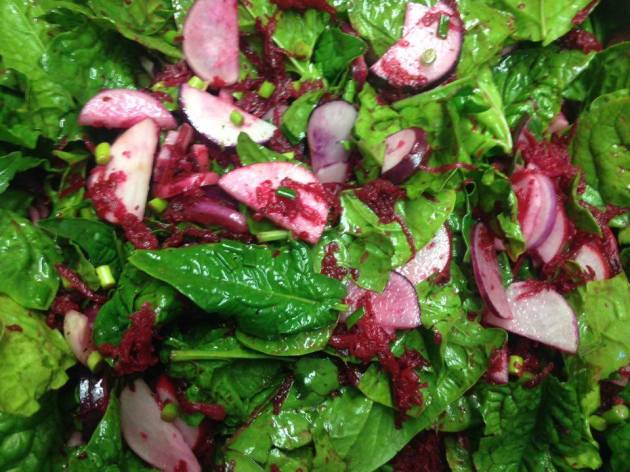
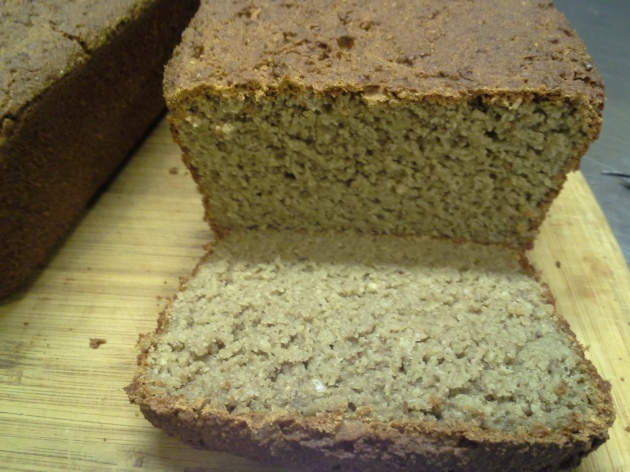
This week I managed to make a pretty good vegan gluten-free bread! Not an easy task. I’ve spent years experimenting with gluten-free baking, with varying success. I’ve been meaning to actually write down recipes and post them, rather than just doing things by sight/memory/improv. Hopefully I’ll get some more gluten-free recipes up soonish. I have a few gloriously gluten-less cakes in mind, like lime-coconut, lemon gel, and mocha gel. But I digress into cake territory, yet again.


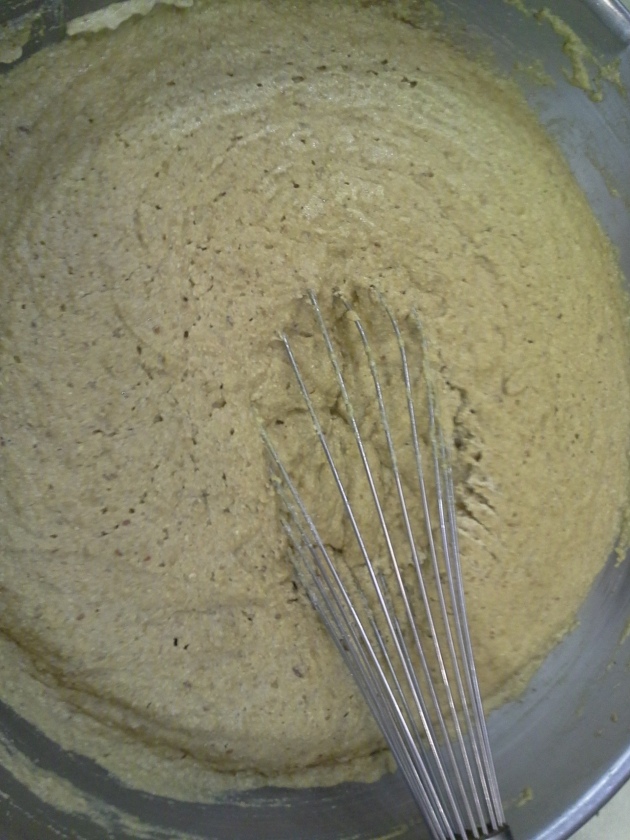
Here’s the dough rising for its first hour. I had to switch over to a wooden spoon at this point.
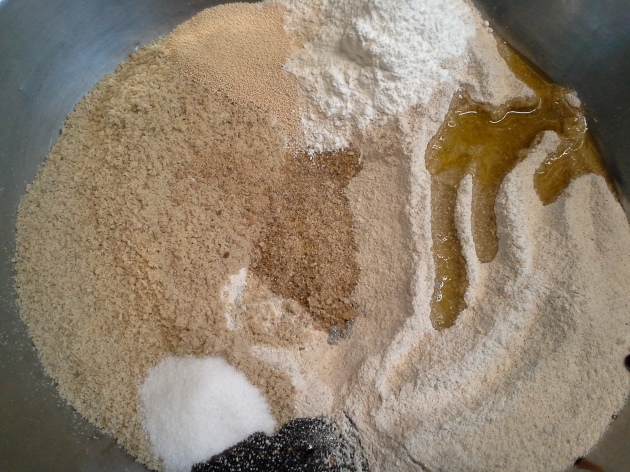
The ingredients together before being whisked, clockwise from left: sunflower seed meal, yeast, flax, baking powder, olive oil, buckwheat flour, molasses, and salt.
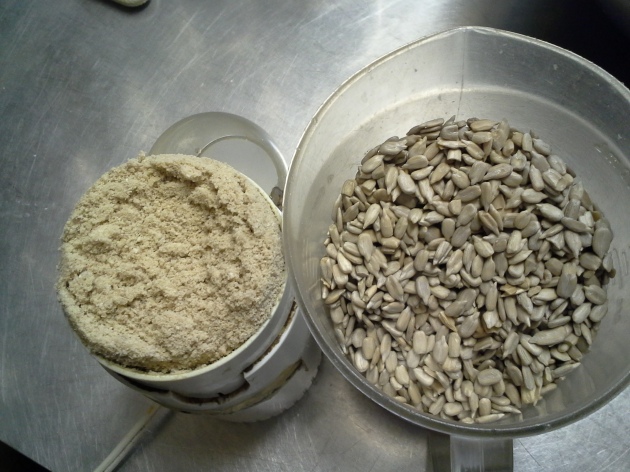
To make sunflower seed flour/meal, just grind raw sunflower seeds until powdery in a coffee/spice grinder. You could also sub out any other nut meal flour, like almond or cashew.
Vegan Gluten-Free Sunflower Seed Bread
makes 2 medium loaves
Ingredients:
4 c sunflower seed meal
3.5 c buckwheat flour
4 tsp flax seeds, ground
1.5 tsp salt
2 TB molasses
2 TB olive oil (Edit: or coconut oil or sesame oil)
1 TB yeast
3 TB baking powder
4 c warm water
Directions:
Whisk together all ingredients and let sit, covered, to rise for an hour. Switch to a wooden spoon, and give the batter/dough a good stir before allowing to rest and rise for a second hour in the bowl. Gluten-free flours, being often of hearty whole grains, benefit from longer sitting to allow the flour to absorb and fully hydrate.
Grease two medium bread pans (not used for glutenous bread). Split the dough between the pans, smoothing the tops just a bit. Let rise in the pans for 40 minutes, until just puffing above the edge of the pans. Gently place in a 350 F oven, bake for 45 minutes. Let the bread cool in the pans for 15 minutes after removing from the oven. Use a butter knife to run along the sides of the pans, then dump the loaves out onto a cutting board. They may need a couple of taps to pop out.
Then, a golden crust. A strong crumb that holds together. A tasty, toasty, nutty flavor that is yeasty like bread, and otherworldly delicious! Whether you’re gluten-free or you have gluten-free friends, a loaf like this, steaming from the oven, is a sight (and taste, and smell) to behold.
Sure, the peculiar taste of buckwheat isn’t for everyone, I just happen to be a lifelong fan of it. Buckwheat is high in magnesium, a natural muscle relaxant. Mixed with the extra protein of the sunflower seeds, a wonderful nuttiness comes out strong, if you enjoy that like I do.
Today I also attempted another VGF bread made from red lentils and rice flour. It was less picturesque, although a pleasant dusty sunset color, and tasted great flavored with basil & rosemary. But that is a bread for another day.
It’s so easy to sprout things, and then they’re alive! Sprouting changes the texture and make-up of beans to make them more edible with less digestive issues, and makes some vitamins more accessible. There’s just something special about eating a live bean rather than a dull, dried bean (nothing against them, I cooked some yummy pinto beans with apples & turmeric the other day). My favorites for sprouting are green lentils, mung beans, alfalfa, chickpeas, and sunflower seeds (raw, not toasted – non-irradiated). Making sprouts adds a fresh-grown item that could be a good substitute for salad during low-yield times in the garden.
I like the way sprouts twist and curl and reach out. And their crisp crunch that tastes so fresh and clean. Here I have added some green lentil sprouts along with mung beans, chickpeas, navy beans, pintos, chard, dill, lemon, & olive oil to make a glorious 5-bean salad, a step up from the white bean salad I’ve been making lately.
First soak your bean/seed of choice (dried, not canned or cooked) in cold water for the first day, to fully hydrate. Then rinse them with fresh cool water twice a day (morning & night), straining the water out. All they need to live is water and a bit of air, and they will start sprouting in a couple of days. When the sprouts are big enough for your taste, refrigerate them to prevent overgrowing. It’s that simple.
I sprout in a metal pot with a holey lid, and strain with a sieve. In the past I’ve used a set-up with glass mason jars fit with screened lids, that you can simply fill with water and strain without having to undo the lid.
We’ve had some red sumac powder in the pantry that someone saved last fall. It’s an unusual item that looks like chili powder but isn’t spicy at all. It tastes very lemony, kind of like a whiskey sour. Here I have combined sumac with lime juice, olive oil, turmeric, white pepper, and pickled beet juice to make a lovely colorful dressing that probably most people weren’t sure what to do with. Also shown here is a coconut-mint-lime dressing (coconut milk adds a creamy factor to vegan dressings), and a spicy thai dressing with a green bell pepper puree.